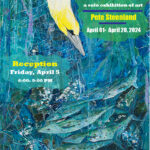By: Tanya Mutton
Catastrophe. “Put the kettle on.” Drama. “Put the kettle on.” Need a good chat? “Put the kettle on.”
 The phrase, “Let me put the kettle on and make a nice cuppa” is usually the first thing English people say to make all things better. It’s a huge part of the social culture and it’s a coping mechanism for when they are not sure what to do in any given situation. It brings people together, morning, noon and night. It encourages socializing. It’s not unusual to see one neighbor “pop ‘round” (visit) to a neighbor’s for a chin wag (talk) or to break the ice with strangers. Figuring things out over a cup of tea has the power to provide the feeling there isn’t anything that can’t be sorted out.
The phrase, “Let me put the kettle on and make a nice cuppa” is usually the first thing English people say to make all things better. It’s a huge part of the social culture and it’s a coping mechanism for when they are not sure what to do in any given situation. It brings people together, morning, noon and night. It encourages socializing. It’s not unusual to see one neighbor “pop ‘round” (visit) to a neighbor’s for a chin wag (talk) or to break the ice with strangers. Figuring things out over a cup of tea has the power to provide the feeling there isn’t anything that can’t be sorted out.
Americans are falling in love with tea and tea parties, and why not? It’s a reminder of a more civilized time. There is something calming and enjoyable when sitting down to a tea party. Sitting down for a cup of tea doesn’t have to be a special occasion, as usually depicted in movies or television shows. Having a cup of tea with someone can and should be enjoyed daily. Being born and bred in Nottingham, England, I hope to give you a view into how the “common folk” enjoy their tea.
I was recently asked by an American friend on Facebook how to make a proper cup of tea “like the English.” At first I let out a little chuckle because it seems such a simple question, similar to “how do you breathe?” When I started to describe the process — water, bag, and mug — someone chimed in that I was “wrong and that it should be loose tea.” Let me just share my opinion here; loose tea may have been used at one time, but like everything in life, innovation has changed the way “regular folk” make tea, after all, this isn’t the Dark Ages. Using a tea bag is a perfectly acceptable method for making your cuppa. This is not to say that a nice cup of that wonderful liquid cannot be made from loose tea, but this can be likened to “why ride the horse when you have a car?”
Many people ask me what type of tea I drink, which I hate to answer because it confuses people. Brits don’t bother with breakfast, Earl Grey or Darjeeling, etc.; these are classed as specialty teas. These days we traditionally drink a black tea from a line of popular brands with milk and sugar. The most popular tea brand in England is PG Tips. I would rate Yorkshire Tea brand a close second. Both are available at Julie’s British Shoppe in downtown Melbourne. Julie has a good array of English goodies or there is a smaller selection at Publix, usually aisle 7. I may or may not spend a lot of time in front of the British section! World Market is a personal favorite too.
How Do I Make a Proper Cuppa?
Alright, down to brass tacks. First we boil the water; an electric kettle is the way to go. I don’t know any Brits personally that use a stove kettle and I’m pretty certain this is the sole reason electricity was invented – to allow Brits to boil water faster for their cuppa. There are two ways you can go from here. For just one person I make what could be called “builders tea.” It’s a term that comes from
construction workers who make their tea from a bag in a mug usually with milk and two sugars. You put the teabag in, pour hot water on it and let it mash (another English term which means to let the tea stew in the water). This is used by northerners of which I am one. Never put the milk and sugar in first; this is a big no-no, not sure why, I just know that it’s not civilized and my mother said so. When it’s a nice golden brown color you remove the teabag. Never leave it sitting in the cup mug; leaving the bag in the cup is a grave offense. The biggest reason is that it ruins the tea. Once the bag is removed, only then do you add your
milk and sugar. Forget lemon, it’s not something that us Brits put in our tea. Milk is the way to go. I prefer mine without sugar, but for many they just can’t remove that bit of sugar from their daily cup. Give it a good stir and then you’re ready for some “dunking.” More on that in a moment. If you are making tea for more than one, then by all means get your teapot out and repeat the steps as before but this time pour the tea from the pot into the cup and let the guests add milk and sugar to their liking. Just remember that before you use your teapot, rinse it out and put some warm water in it to heat up the ceramic. Then dump that water and replace with hot water and continue. Any tea that is left over can be kept nice and hot by putting what is called a tea cozy over the tea pot. A tea cozy will also help keep the tea hot while it is mashing.
 Dunking
Dunking
No, this isn’t some sort of basketball move; this is one of the best kept secrets that Brits enjoy and I am so surprised it hasn’t translated over to the states as more and more British food becomes available. While everyone knows that a nice slice of cake, scone, cucumber sandwich or muffin goes down great with a cup of tea, we Brits love to dunk our biscuits (cookies) or “bikkies” in a cup of tea. For the beginner, I would recommend McVities Digestives or McVities Hob Nobs. They are a good solid bikkie and won’t drop into your tea too often.
It’s an art, and can take skill and a great sense of timing. The type of biscuit affects your dunking time – dunk too long and it will break off, leaving a nice soggy mess at the bottom of your cup.
If you want to try the tradition of tea dunking, there is a wide variety of biscuits at Julie’s British Shoppe, Publix and World Market. Julie’s British Shoppe, in downtown Melbourne has a tea tasting event that runs on Saturdays from 11am to 4pm. (www.britishshoppe.net)
I could natter (talk) on for hours and hours about British tea time and tea etiquette, but my advice is to forget the fancy stuff and go full Brit, invite some friends, put the kettle on and get dunking.











